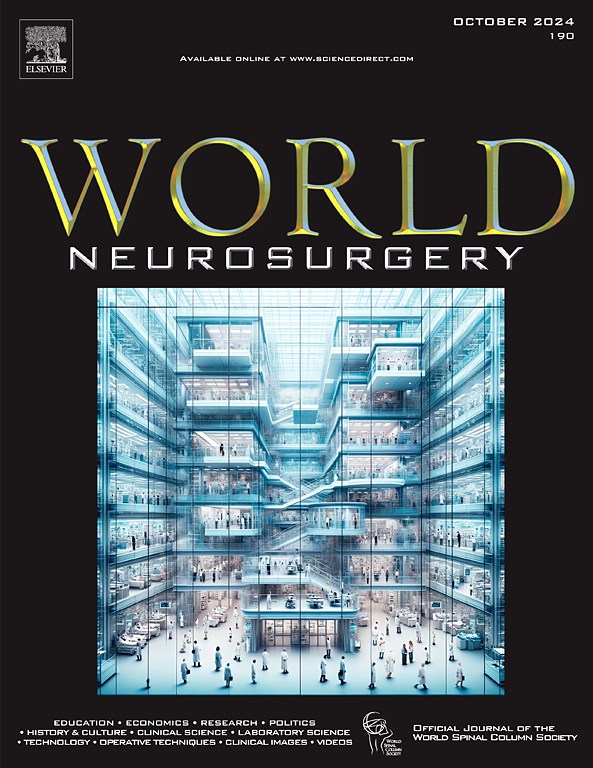Age and Time as Predictors of Outcome in Patients Undergoing Decompressive Craniectomy for Traumatic Brain Injury
IF 2.1
4区 医学
Q3 CLINICAL NEUROLOGY
引用次数: 0
Abstract
Background
Evidence to support the benefit of decompressive craniectomy (DC) in traumatic brain injury (TBI) is diverging. Moreover, in the context of an aging population, there is a notable lack of direct evidence supporting the efficacy of DC in older age groups. In this study, we evaluate the impact of age on outcome after DC for TBI in a single-center cohort. Additionally, we explore the effect of time from injury to DC on outcome.
Methods
In this retrospective cohort study based on prospectively collected data from the Oslo TBI Registry Neurosurgery, we included TBI patients of any age admitted to Oslo University Hospital from 2015 to 2023 who had undergone DC. Dichotomized 6-month Glasgow Outcome Scale was analyzed for the whole cohort and stratified by patient age and time from TBI to DC in both univariable and multivariable analyses.
Results
Eighty-six patients were included. Median age was 41 years (range 2–79 years), and the median time from injury to DC was 7 hours (interquartile range 3–35 hours). Unfavorable outcome (Glasgow Outcome Scale 1–3) varied significantly according to both age group (≥60 years: 92%, 40–59 years: 67%, 20–39 years: 46%, and 0–19 years: 50%; P = 0.022) and whether the patient required early or later DC (DC ≤ 6 hours: 74%, DC > 6 hours: 50%; P = 0.023). In multivariable logistic regression, age (β 0.09, 95% confidence interval 0.03–0.14; P = 0.003) and time from injury to DC (β −0.02, 95% confidence interval −0.03 to 0.00; P = 0.02) remained associated with unfavorable outcome.
Conclusions
Older age and requiring DC earlier rather than later were associated with unfavorable outcomes after DC for TBI.
年龄和时间作为创伤性脑损伤患者行减压颅骨切除术预后的预测因素。
背景:支持减压颅骨切除术(DC)治疗创伤性脑损伤(TBI)益处的证据正在分化。此外,在人口老龄化的背景下,明显缺乏直接证据支持DC在老年群体中的有效性。在本研究中,我们在单中心队列中评估年龄对TBI DC后预后的影响。此外,我们探讨了从损伤到DC的时间对结果的影响。方法:在这项回顾性队列研究中,基于前瞻性收集的奥斯陆TBI神经外科登记处的数据,我们纳入了2015 - 2023年在奥斯陆大学医院接受DC治疗的任何年龄的TBI患者。在单变量和多变量分析中,对整个队列的6个月格拉斯哥结果量表(GOS)进行分析,并根据患者年龄和从TBI到DC的时间进行分层。结果:共纳入86例患者。中位年龄为41岁(范围2-79岁),从损伤到DC的中位时间为7小时(IQR 3-35小时)。不良结局(GOS 1-3)根据两组年龄组(≥60岁:92%,40-59岁:67%,20-39岁:46%,0-19岁:50%,p=0.022)和患者是否需要早期或晚期DC (DC≤6h: 74%, DC≤6h: 50%, p=0.023)有显著差异。在多变量logistic回归中,年龄(β 0.09, 95%CI 0.03-0.14; p=0.003)和从损伤到DC的时间(β -0.02, 95%CI -0.03-0.00; p=0.02)仍然与不良结果相关。结论:年龄越大,需要更早而不是更晚的DC与TBI DC后的不良结果相关。
本文章由计算机程序翻译,如有差异,请以英文原文为准。
求助全文
约1分钟内获得全文
求助全文
来源期刊

World neurosurgery
CLINICAL NEUROLOGY-SURGERY
CiteScore
3.90
自引率
15.00%
发文量
1765
审稿时长
47 days
期刊介绍:
World Neurosurgery has an open access mirror journal World Neurosurgery: X, sharing the same aims and scope, editorial team, submission system and rigorous peer review.
The journal''s mission is to:
-To provide a first-class international forum and a 2-way conduit for dialogue that is relevant to neurosurgeons and providers who care for neurosurgery patients. The categories of the exchanged information include clinical and basic science, as well as global information that provide social, political, educational, economic, cultural or societal insights and knowledge that are of significance and relevance to worldwide neurosurgery patient care.
-To act as a primary intellectual catalyst for the stimulation of creativity, the creation of new knowledge, and the enhancement of quality neurosurgical care worldwide.
-To provide a forum for communication that enriches the lives of all neurosurgeons and their colleagues; and, in so doing, enriches the lives of their patients.
Topics to be addressed in World Neurosurgery include: EDUCATION, ECONOMICS, RESEARCH, POLITICS, HISTORY, CULTURE, CLINICAL SCIENCE, LABORATORY SCIENCE, TECHNOLOGY, OPERATIVE TECHNIQUES, CLINICAL IMAGES, VIDEOS
 求助内容:
求助内容: 应助结果提醒方式:
应助结果提醒方式:


